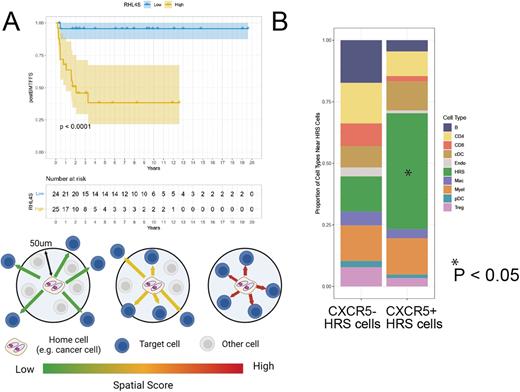Abstract
INTRODUCTION: Despite recent treatment advances, about half of relapsed or refractory classic Hodgkin lymphoma (r/r CHL) patients succumb to their disease after high dose chemotherapy followed by autologous stem cell transplantation (HDT/ASCT). Our group has previously developed a gene expression based prognostic assay (RHL30) that identifies high-risk r/r CHL patients treated with HDT/ASCT (J Clin Oncol 2017). However, RHL30 does not incorporate important information about cellular interactions, specific expression features of Hodgkin and Reed-Sternberg (HRS) cells and the spatial architecture of the tumor-microenvironment (TME). Here, we aimed to determine spatially resolved TME ecosystems and establish novel biomarkers associated with treatment failure in r/r CHL.
METHODS: Using a customized marker panel specific for CHL biology, we performed imaging mass cytometry (IMC) using a tissue microarray containing formalin-fixed paraffin-embedded tissues from 169 CHL tumors, including 73 patients with paired primary and relapse samples, as well as 23 pretreatment diagnostic samples from patients in long-term remission. Segmentation was performed by the Ilastik machine learning package following the Bodenmiller IMC segmentation pipeline to obtain single cell level data. We used the Phenograph clustering algorithm to identify major cell types and functional subsets. For each cell, we calculated a spatial cell enrichment score, called 'spatial score', of a given cell type as the distance to the five nearest neighbor cells, capped at the spatial interaction range (50um). Patients were classified as having early relapse disease if their CHL progressed within 12 months after initial diagnosis. For prognostic model development, we used an empirical Bayesian approach based on LPS (linear prediction score).
RESULTS: We obtained highly multiplexed images for a total of 7,146,042 cells that could be broadly clustered into T cell, macrophage, B cell as well as HRS cells using the phenograph tool. We also identified subsets within the HRS cell cluster, such as GATA3-high HRS cells and CXCR5-high HRS cells. We, then, investigated the difference of TME characteristics according to the disease status. Overall, CHL biopsies from early relapse demonstrated shared TME patterns between diagnostic and relapse samples, and were characterized by a lesser extent of CD8+ cells (P < 0.01) as well as enrichment of a myeloid cell population (P < 0.05). In contrast, late relapse samples often demonstrated significant TME changes between diagnostic and relapse biopsies (P < 0.01).
Considering the previous finding of the superiority of relapse biopsies for outcome prediction in comparison to pretreatment diagnostic samples in r/r CHL, we again focused our prognostic model development on relapse biopsies. Using LASSO based analyses, four variables, CXCR5+ HRS cells (Hazard Ratio [HR]: 2.86), PD1+ CD4+ T cells (HR: 2.80), macrophage (HR: 1.99), and CXCR5+ B cells (HR: 0.19) were identified as factors that were significantly associated with post-ASCT failure free survival (FFS). Using these 4 variables, we developed a spatial score-based prognostic model (RHL-4S) and compared performance with a classical protein%-based model. The RHL-4S produced a high-risk group of patients with significantly inferior post-ASCT FFS compared with the low-risk group (5-year post-ASCT FFS: high risk, 38% vs low risk, 96%; P < 0.0001, Figure A) as well as inferior post-ASCT overall survival (OS) (5-year post-ASCT OS: high risk, 45% vs low risk, 95%; P < 0.0025).
IMC analyses furthermore identified unique spatial architecture defined by CXCR5+ HRS cells. In particular, CXCR5+ HRS cells were spatially arranged together with other HRS cells forming cell clusters as an architectural feature (P < 0.05, Figure B). CXCR5+ HRS cells in these clusters were also characterized by a lower abundance of neighboring non-malignant immune cells, including CD4+ T cells and CD20+ B cells when compared to CXCR5- HRS cells.
CONCLUSION We developed a novel prognostic model, RHL-4S, applicable to relapse biopsies of r/r CHL patients who were treated with ASCT. In particular, we have shown the interaction between CXCR5 on HRS cells with ligand-expressing CXCL13+ follicular T helper cells (Aoki et al, PNAS 2021) and macrophages as a prominent crosstalk axis in relapsed disease. This insight opens new avenues to predictive biomarker development.
Disclosures
Savage:Beigene and Regeneron: Membership on an entity's Board of Directors or advisory committees; BMS, Janssen, Kyowa, Merck, Novartis, and Seattle Genetics: Consultancy, Membership on an entity's Board of Directors or advisory committees. Scott:NanoString: Patents & Royalties; AstraZeneca: Consultancy, Honoraria; Incyte: Consultancy; Janssen: Consultancy, Research Funding; Abbvie: Consultancy; Roche: Research Funding. Steidl:Abbvie: Consultancy; Bayer: Consultancy; Bristol Myers Squibb: Consultancy; Curis Inc: Consultancy; Epizyme: Research Funding; Roche: Consultancy; Seattle Genetics: Consultancy; Trillium Therapeutics: Research Funding.
Author notes
Asterisk with author names denotes non-ASH members.


This feature is available to Subscribers Only
Sign In or Create an Account Close Modal